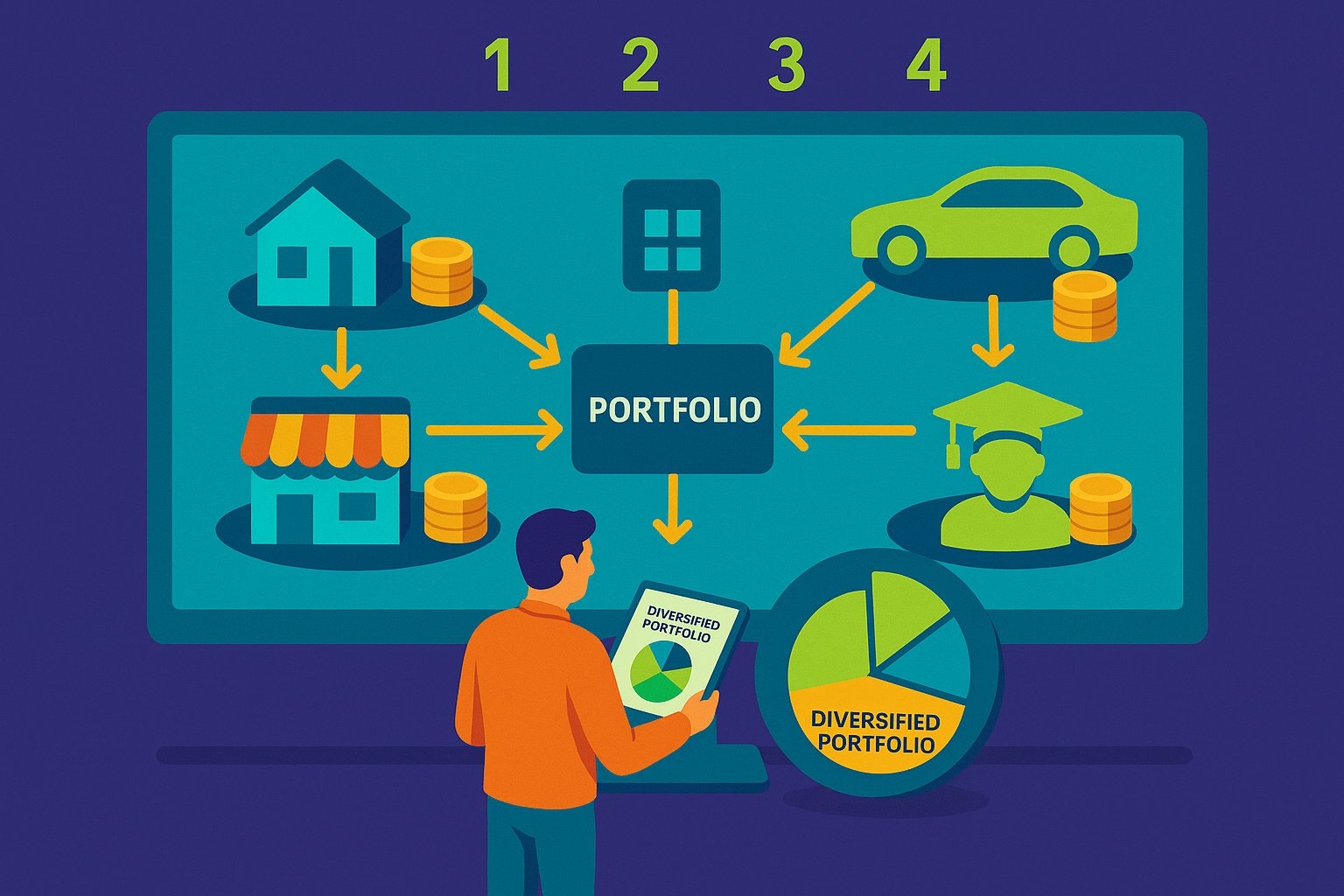P2P Lending for Steady Returns
In an era where passive income has become a mantra for financial freedom, peer-to-peer (P2P) lending has emerged as a potent avenue for investors to generate consistent yields. Unlike traditional savings accounts or dividend stocks, P2P lending allows individuals to directly fund loans for creditworthy borrowers through online marketplaces, capturing interest that once was the exclusive domain of banks. The allure is clear: attractive interest rates coupled with manageable risk when approached strategically. To fully harness P2P lending’s potential, however, you must adopt a systematic approach—one that balances diversification, rigorous due diligence, and disciplined portfolio management. This article delves into the top strategies for securing reliable passive income via P2P lending, guiding both newcomers and seasoned investors toward constructing a resilient, high-performing loan portfolio.
Charting Your Financial Course with Clear Objectives
Every successful investment venture begins with precise goal-setting. Before embarking on a P2P lending journey, clarify your desired income targets, acceptable risk thresholds, and investment horizon. Are you seeking monthly cash flow to supplement your salary, or do you aim to reinvest earnings over several years for compounding growth? Articulating these objectives lays the foundation for your P2P lending strategy. For instance, if immediate cash flow is paramount, you may prioritize short-term loans with proven borrowers. Alternatively, if compounding is your goal, reinvesting principal and interest in longer-term loans could amplify returns over time. By defining your financial destination upfront, you ensure every subsequent decision—platform selection, loan allocation, risk management—aligns with your overarching vision, preventing emotional or impulsive deviations when market conditions shift.
Selecting the Right P2P Platforms for Your Goals
Not all P2P marketplaces are created equal. Some platforms specialize in consumer debt consolidation loans, while others emphasize small business financing or real estate mortgages. Begin by evaluating each platform’s reputation, regulatory compliance, and historical performance data. Look for transparent metrics: average interest rates by loan grade, default and recovery histories, and borrower verification processes. Ensure that the site operates under robust regulatory frameworks—whether overseen by the Securities and Exchange Commission (SEC) in the United States or equivalent authorities elsewhere—to safeguard your investments. In addition, examine the platform’s fee structure: origination fees paid by borrowers, servicing fees deducted from interest payments, and potential withdrawal fees. A platform with slightly lower headline yields but minimal fees might ultimately deliver superior net returns. By aligning platform characteristics with your risk tolerance and income objectives, you set a sturdy stage for consistent passive earnings.
Building a Diversified Loan Mosaic for Steady Stability
Diversification is the cornerstone of mitigating risk in P2P lending. Rather than funding a handful of high-yield, subprime loans—where the allure of double-digit interest may entice but the default risk looms large—spread your capital across dozens or even hundreds of loans. By allocating funds across various borrower credit grades, term lengths, and loan types (such as unsecured personal loans, secured real estate loans, and small business loans), you reduce the impact of any one borrower’s default. For example, combining short-term prime-grade personal loans with longer-term mortgages backed by property collateral can create a balanced income stream. Geographic diversification also matters: when you invest in borrowers from different states or regions, localized economic downturns become less likely to jeopardize your entire portfolio. The goal is to smooth out fluctuations—defaults and late payments become manageable if they represent only a small fraction of your overall holdings. Over time, this diversified approach fosters predictable, resilient passive income.
Embracing Automated Reinvestment to Harness Compounding Power
The true magic of P2P lending lies in compounding returns. Most reputable platforms offer automated reinvestment features, allowing interest and principal repayments to be redeployed into new loans matching your preset criteria. By activating auto-invest options, you eliminate the friction of manual loan selection, ensuring your capital is continuously at work rather than sitting idle. To set this up wisely, specify parameters that align with your strategy: minimum credit grade thresholds, preferred loan durations, and acceptable interest rate ranges. Periodically review and adjust these filters to reflect changing market conditions—if interest rates rise, you may opt for higher-yield loans, whereas during economic uncertainty, tightening credit-grade requirements can safeguard your portfolio. Automated reinvestment also reduces time commitments, freeing you to focus on broader portfolio analysis rather than individual loan listings. When executed thoughtfully, this hands-off, disciplined approach harnesses the full power of compounding, exponentially increasing your passive income over the long run.
Conducting Rigorous Due Diligence on Borrower Profiles
While P2P platforms streamline the lending process, it remains critical to perform due diligence on borrower profiles before committing funds. Examine the borrower’s credit score, debt-to-income ratio, employment history, and any additional data points provided by the platform—such as bank transaction histories or alternative credit signals. Some platforms incorporate machine learning algorithms to assess borrower risk, while others rely solely on traditional credit bureaus. Understanding the underwriting methodology helps you calibrate expectations and select loans that align with your risk tolerance. For instance, borrowers with stable employment and minimal existing debt typically carry lower default probabilities than self-employed individuals in volatile industries. If the platform allows it, review past repayment patterns: recurring late payments or recent delinquency incidents can signal heightened risk. While no underwriting model is foolproof, combining platform-provided insights with your own scrutiny empowers you to make informed lending decisions, reducing the likelihood of non-performing loans disrupting your passive income stream.
Structuring a Balanced Blend of Loan Durations
Loan duration plays a significant role in both income consistency and liquidity management. Shorter-term loans—those maturing in six to twelve months—offer faster principal turnover, enabling reinvestment or access to funds should financial needs arise. However, they may come with slightly lower yields compared to multi-year loans, which often command higher interest rates to compensate for extended credit risk. Crafting the ideal mix of loan durations—sometimes referred to as a “loan ladder”—ensures a steady cadence of repayments. For example, you might allocate 40% of your capital to loans maturing within a year, 40% to 12–24 month loans, and 20% to 24–36 month loans. As short-term loans complete, the principal is freed to enter new opportunities, maintaining a consistent flow of capital. Meanwhile, longer-duration loans lock in attractive interest rates for extended periods, bolstering overall portfolio yield. By balancing loan tenures, you create a self-reinforcing cycle that blends reliable cash flow with optimized returns.
Monitoring Portfolio Health and Reacting to Market Signals
Launching a diversified, auto-invested portfolio is just the beginning; ongoing oversight is essential to maintain robust passive income. Regularly review performance metrics provided by your P2P platform—average monthly returns, number of late versus current loans, and cumulative default rates. Compare these figures against historical benchmarks and wider economic indicators such as unemployment trends, consumer spending data, and inflation forecasts. When you notice patterns—like a cluster of late payments in a specific credit grade or sector—it may be time to adjust your lending filters or pause additional investments in higher-risk categories. If a platform introduces new loan products or shifts underwriting criteria, reevaluate how these changes align with your objectives. Additionally, maintain awareness of broader financial environment shifts; rising benchmark interest rates might present opportunities to secure higher-yield loans, while economic contractions could warrant a pivot toward more conservative credit tiers. A proactive, data-driven approach to portfolio management ensures your passive income stream remains steady, even as landscapes evolve.
Safeguarding Against Concentration and Unexpected Defaults
Even with robust diversification, occasional borrower defaults are inevitable. The key is to ensure that no single default—or small cluster of defaults—jeopardizes your entire passive income machine. To guard against concentration risk, set maximum exposure limits per individual loan, borrower category, or geographic region. For instance, you might restrict any single loan to no more than 2% of your total portfolio value. Additionally, monitor default rates across different borrower segments—such as credit grades or loan durations—and adjust your allocation if certain categories consistently underperform. Some platforms offer reserve funds or “loan loss reserves” that reimburse investors up to a certain percentage when defaults surpass predetermined thresholds. While these mechanisms can cushion losses, they vary widely in reliability and coverage. By constructing safeguards—both in the form of diversified exposure and platform-level protection—you can weather isolated setbacks with minimal disruption to your passive income expectations.
Cultivating a Long-Term Mindset for Sustainable Gains
Achieving consistent passive income through P2P lending is not a get-rich-quick scheme. Rather, it demands patience, disciplined reinvestment, and a willingness to weather market cycles. When you see initial returns accumulating, resist the temptation to chase unsustainably high-yield loans that might incur disproportionate risk. Instead, focus on maintaining allocation balance across credit grades and loan durations, so that your portfolio absorbs the shocks of occasional economic downturns without derailing long-term objectives. Set aside a regular time—monthly or quarterly—to conduct a thorough portfolio review, recalibrating auto-invest settings as needed, and reallocating funds from matured loans into newly discovered opportunities. Over years of consistent monitoring and adjustment, your compounded earnings can significantly outpace the modest yields of traditional fixed-income instruments. By embracing a long-term perspective—anchored in the knowledge that small, steady gains accumulate into substantial wealth—you position your P2P lending enterprise for lasting success.
Leveraging Tax-Efficient Structures to Maximize Net Returns
While P2P lending can generate attractive interest income, it is essential to account for tax implications to safeguard your net gains. In many jurisdictions, interest collected from P2P loans is treated as ordinary income, potentially subjecting you to higher tax rates than capital gains. To optimize your tax position, consider utilizing tax-deferred or tax-exempt accounts—such as individual retirement accounts (IRAs) or self-directed 401(k)s in the United States—to hold P2P loan investments. Doing so delays or even eliminates tax obligations on interest earnings, allowing compounding to proceed unhindered. Alternatively, if tax-advantaged accounts are unavailable or insufficient, maintain meticulous records of interest income, loan principal losses, and any platform fees, ensuring accurate reporting on annual tax filings. In some countries, losses from defaulted loans may qualify for deduction as bad debts, subject to specific guidelines. Consulting a tax professional with expertise in marketplace lending can help you navigate local regulations, ensuring that your P2P lending strategy delivers maximum after-tax returns.
Reinforcing Your Network and Staying Ahead of Trends
P2P lending is an innovative ecosystem that evolves swiftly alongside broader financial and technological trends. To stay ahead of emerging opportunities and potential risks, engage with the P2P community through online forums, social media groups, and industry conferences. Participating in peer discussions often uncovers firsthand experiences—such as how recent economic shifts affect default rates or which platforms are launching new loan categories with unique risk-return profiles. Reading platform newsletters and subscribing to industry publications can also illuminate regulatory developments or breakthroughs in alternative credit scoring methodologies. Additionally, networking with fellow investors allows you to benchmark your portfolio strategy, gaining insight into how others allocate funds, handle economic downturns, and optimize auto-invest settings. By cultivating an ongoing dialogue with like-minded peers and staying attuned to the broader lending landscape, you ensure that your tactics remain agile, informed, and capable of delivering consistent passive income even as market dynamics shift.
Charting Your Course to Reliable P2P Income
Securing sustained passive income through P2P lending is both an art and a science. As this guide has outlined, the journey begins with clear objectives and rigorous platform selection, followed by disciplined diversification across loan types, durations, and geographies. Automated reinvestment simplifies compounding, while careful monitoring and prudent risk management guard against economic headwinds. By adopting a long-term perspective, optimizing for tax efficiency, and staying embedded within the P2P community, you transform a digital loan marketplace into a dependable engine for financial growth. While occasional defaults and market fluctuations are inevitable, a robust, data-driven approach ensures that your overall income stream remains resilient. As you embark on—or refine—your P2P lending experience, remember that incremental gains, when compounded over years, create a powerful legacy of passive earnings. Embrace these strategies, remain vigilant, and watch as your portfolio evolves into a consistent source of income that supports your financial aspirations.




